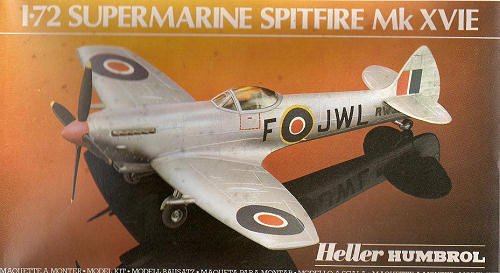
Heller 1:72 Supermarine Spitfire Mk.XVIE
| KIT #: | 80282 |
| PRICE: |
Ł3.99 |
| DECALS: | Two options |
| REVIEWER: | Zac Yates |
| NOTES: |

| HISTORY |
The Mk.XVI – essentially a IX with a Packard-built Merlin up front – was the last Merlin-powered Spitfire. Most Mk XVI had a clear vision canopy and served for many years post war in various Allied air forces. For greater detail check out any of the many reviews of this variant in the Review Archives right here in MM.
| THE KIT |
 This
is the first Heller kit I’ve had for a very long time, if not the first. It
shows its age with fairly thick plastic and raised panel lines (and rather large
rivets!). My copy of this kit arrived on four silver sprues and one clear. I
must mention the canopy right away. It is in two parts and, as a
“low-back/bubble” Spit, it should be very easy to do her with the canopy open.
Compared to the Matchbox kit this one looks a little higher, thus more like the
real deal.
This
is the first Heller kit I’ve had for a very long time, if not the first. It
shows its age with fairly thick plastic and raised panel lines (and rather large
rivets!). My copy of this kit arrived on four silver sprues and one clear. I
must mention the canopy right away. It is in two parts and, as a
“low-back/bubble” Spit, it should be very easy to do her with the canopy open.
Compared to the Matchbox kit this one looks a little higher, thus more like the
real deal.
There is virtually no flash on any parts, and only a couple of ejector towers to
remove (headrest, canopy). The
cannon and stubs are moulded integrally with the two upper wing halves, and the
spent shell chutes on the underside are already open for you. The ailerons are
moulded on both upper and lower wing surfaces so you may wish to sand a little
to gain a more scale thickness. The clipped wingtips are already moulded onto
the parts. The radiators are also moulded on the wing and have some square
shapes to put in and block it off. Some say the radiators look more like those
from a Griffon Spit as they’re rather deep, so again you may wish to cut them
off, sand a little and reattach. The “gull” is moulded into the wing, so that’s
at least one bonus for the boffins out there.
Two kinds of exhaust are provided, one being “fishtails” (very finely moulded)
and the second being more standard “tubes”. Cockpit detail is fair, including a
deep seat, instrument panel (with raised rudder pedals), blank floor, rear
bulkhead and control stick with spade grip. The four-blade prop is one piece
with a nice spinner and backplate, and the combo seems to catch the XVI look
quite nicely. The large undernose intake is moulded as two halves, so the seam
here may cause a bit of a problem for some.
 Decals
include two options: RW396/
Decals
include two options: RW396/
The instructions are a folded A4, paint details on one side and assembly on the other. Nice and clear, so this would be a nice kit to get someone into the hobby. Another folded A4 has a full list of Heller and Humbrol paints (numbers and names), “General Modelling Advice” in eight languages and the mandatory complaints form.
| CONCLUSIONS |
All in all this appears to be a very fine kit of an infrequently moulded mark. Later issues of Matchbox’s Mk.IX kit include an option to make it as a low-back, but I believe Heller’s kit is the only injection-moulded one that makes a low-back Merlin Spitfire out of the box. Recommended for both beginners and the Spitspert.
May 2009
If you would like your product reviewed fairly and quickly, please contact me or see other details in the Note to Contributors.